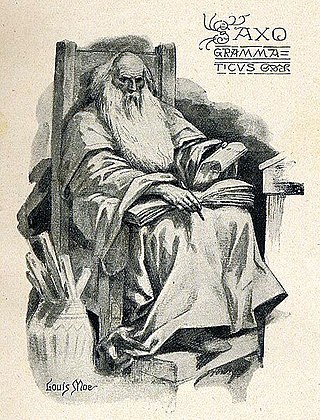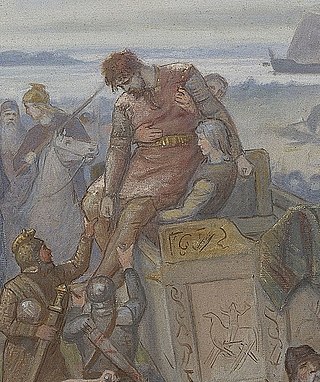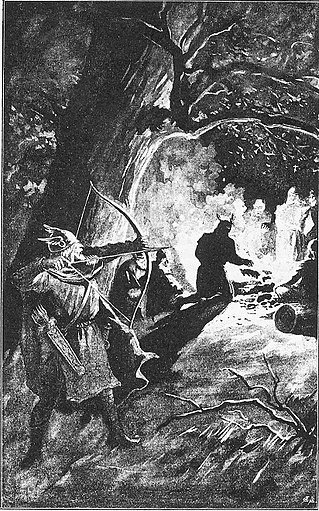
Gesta Danorum is a patriotic work of Danish history, by the 12th-century author Saxo Grammaticus. It is the most ambitious literary undertaking of medieval Denmark and is an essential source for the nation's early history. It is also one of the oldest known written documents about the history of Estonia and Latvia.

Ragnar Lodbrok, according to legends, was a Viking hero and a Swedish and Danish king.

Saxo Grammaticus, also known as Saxo cognomine Longus, was a Danish historian, theologian and author. He is thought to have been a clerk or secretary to Absalon, Archbishop of Lund, the main advisor to Valdemar I of Denmark. He is the author of the Gesta Danorum, the first full history of Denmark, from which the legend of Amleth would come to inspire the story of Hamlet by Shakespeare.
Fróði is the name of a number of legendary Danish kings in various texts including Beowulf, Snorri Sturluson's Prose Edda and his Ynglinga saga, Saxo Grammaticus' Gesta Danorum, and the Grottasǫngr. A Danish king by this name also appears as a minor character in the Middle High German epic Rabenschlacht. The name is possibly an eponym for the god Freyr.

Harald Wartooth or Harold Hiltertooth was a semi-legendary king of Denmark who is mentioned in several traditional sources. He is held to have (indirectly) succeeded his father as king of Zealand and to have expanded his realm. According to different sources, he may have ruled over Jutland, part of Sweden and the historical northern German province of Wendland. He is said to have been finally defeated and killed at the legendary Battle of Bråvalla.

Styrbjörn the Strong according to late Norse sagas was a son of the Swedish king Olof, and a nephew of Olof's co-ruler and successor Eric the Victorious, who defeated and killed Styrbjörn at the Battle of Fyrisvellir. As with many figures in the sagas, doubts have been cast on his existence, but he is mentioned in a roughly contemporaneous skaldic poem about the battle. According to legend, his original name was Björn, and Styr-, which was added when he had grown up, was an epithet meaning that he was restless, controversially forceful and violent.

Palnatoke or Palnatoki, sometimes written Palna-Toki or Palna Toki, was a legendary Danish hero and chieftain of the island of Fyn. According to the Jómsvíkinga saga, Palnatoki founded the brotherhood of Jomsvikings and established its laws.

Hjaðningavíg, the legend of Heðinn and Hǫgni or the Saga of Hild is a Germanic heroic legend about a never-ending battle which is documented in Sörla þáttr, Ragnarsdrápa, Gesta Danorum, Skíðaríma and in Skáldskaparmál. It is also held to appear on the image stone at Stora Hammar on Gotland. Moreover, it is alluded to in the Old English poems Deor and Widsið, and in the Old Norse Háttalykill inn forni, and a version of it survived down to the 18th century in the traditional Norn language ballad "Hildina". An altered version of the saga is found in the Middle High German poem Kudrun, as a prologue to the story of Kudrun herself. Yet another version is found in the Old Yiddish Dukus Horant.
Ásmundar saga kappabana is the saga of Asmund the Champion-Killer, a legendary saga from Iceland, first attested in the manuscript Stockholm, Royal Library, Holm. 7, 4to, from the first half of the fourteenth century. It is essentially an adaptation of the German Hildebrandslied, but it has assimilated matter from the Tyrfing Cycle.

Harthacnut or Cnut I was a semi-legendary King of Denmark. The old Norse story Ragnarssona þáttr makes Harthacnut son of the semi-mythic viking chieftain Sigurd Snake-in-the-Eye, himself one of the sons of the legendary Ragnar Lodbrok. The saga in turn makes Harthacnut the father of the historical king, Gorm. It has been suggested he is to be identified with the Hardegon of Northmannia whose early-10th century conquest of Denmark was related by Adam of Bremen.

Thyra was the wife of King Gorm the Old of Denmark, and one of the first queens of Denmark widely believed by scholars to be historical rather than legendary. She is presented in medieval sources as a wise and powerful woman who ordered the building or fortification of the Danevirke, consistent with her commemoration on multiple Viking Age runestones. These include those at Jelling which was the seat of power for her dynasty.
Skjöldr was among the first legendary Danish kings. He is mentioned in the Prose Edda, in Ynglinga saga, in Chronicon Lethrense, in Sven Aggesen's history, in Arngrímur Jónsson's Latin abstract of the lost Skjöldunga saga and in Saxo Grammaticus' Gesta Danorum. He also appears in the Old English poem Beowulf. The various accounts have little in common.

Hamlet Had an Uncle: A Comedy of Honor is a novel by James Branch Cabell, published in 1940. It is the second book of his trilogy Heirs and Assigns. Cabell had incubated a 'true version' of the Hamlet story for decades, and based his tale on Saxo Grammaticus, whose epic saga recounts the story of the historical Hamlet, Prince of Jutland, his murder of his father Horvendill, and his rivalry with Wiglek, the Prince of Denmark.

Gertrude and Claudius is a novel by John Updike. It uses the known sources of William Shakespeare's Hamlet to tell a story that draws on a rather straightforward revenge tale in medieval Denmark, as depicted by Saxo Grammaticus in his twelfth-century Historiae Danicae. It also incorporates extra plot elements added by François de Belleforest in his Histoires tragiques, published in 1576, and furthermore brings in various elements from Shakespeare's play itself, including the name "Corambis" for Polonius from the "bad quarto" of 1603. This story, in its three forms, is primarily concerned with Hamlet avenging his father's murder, but the story starts earlier. The novel is concerned with that earlier life of Gertrude, Claudius, and old Hamlet, and it ends at the close of Act I, scene ii of Hamlet.
Hrœrekr Ringslinger or Ringscatterer was a legendary 7th-century king of Zealand or Denmark, who appears in Gesta Danorum, Gesta Danorum på danskæ, Sögubrot, Njáls saga, Hversu Noregr byggðist, Skjöldunga saga, and Bjarkarímur. Connection with such historical figures such as Horik I, who ruled Denmark around 854 for a dozen or so years, or the founder of the Rurik dynasty is fraught with difficulty.
Feng was a legendary Jutish chieftain and the prototype for William Shakespeare's King Claudius. He appears in Saxo Grammaticus' Gesta Danorum and Gesta Danorum på danskæ.

The sources of Hamlet, Prince of Denmark, a tragedy by William Shakespeare believed to have been written between 1599 and 1601, trace back as far as pre-13th century. The generic "hero-as-fool" story is so old and is expressed in the literature of so many cultures that scholars have hypothesized that it may be Indo-European in origin. A Scandinavian version of the story of Hamlet was put into writing around 1200 AD by Danish historian Saxo Grammaticus in his work Gesta Danorum. It is from this work that Shakespeare borrowed to create Hamlet. Similar accounts are found in the Icelandic Saga of Hrolf Kraki and the Roman legend of Lucius Junius Brutus, both of which feature heroes who pretend to be insane in order to get revenge. A reasonably accurate version of Saxo's story was translated into French in 1570 by François de Belleforest in his Histoires Tragiques. Belleforest embellished Saxo's text substantially, almost doubling its length, and introduced the hero's melancholy.

Lagertha, according to legend, was a Viking ruler and shield-maiden from what is now Norway, and the onetime wife of the famous Viking Ragnar Lodbrok. Her tale was recorded by the chronicler Saxo in the 12th century. According to the historian Judith Jesch, Saxo's tales about warrior women are largely fictional; other historians wrote that they may have a basis in tales about the Norse deity Thorgerd.
The Tale of Ragnarr Loðbrók is an Icelandic legendary saga of the 13th century about the Viking ruler Ragnarr loðbrók. It is first found in the same manuscript as Vǫlsunga saga, which it immediately follows. The tale covers the origin of Áslaug, Ragnarr's quest for the hand of Þóra borgarhjǫrtr, his later marriage to Áslaug, the deeds of their sons in battle, and Ragnarr's death at the hands of king Ælla of Northumbria.
There are two sites in Denmark presented as Hamlet's Grave, the burial site of Amleth, the Jutish chieftain of historical legend on whom Hamlet, the hero of Shakespeare's tragedy was based; one is in the grounds of Marienlyst Castle in Helsingør, the other is a Bronze Age tumulus in Ammelhede, Randers Municipality, Jutland.












